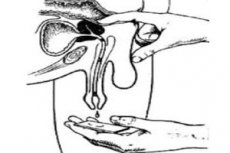Medical expert of the article
New publications
Prostate secretion analysis
Last reviewed: 04.07.2025

All iLive content is medically reviewed or fact checked to ensure as much factual accuracy as possible.
We have strict sourcing guidelines and only link to reputable media sites, academic research institutions and, whenever possible, medically peer reviewed studies. Note that the numbers in parentheses ([1], [2], etc.) are clickable links to these studies.
If you feel that any of our content is inaccurate, out-of-date, or otherwise questionable, please select it and press Ctrl + Enter.

Laboratory testing of biological fluid secreted by the prostate gland – prostate secretion analysis – is a non-invasive (painless and safe) diagnostic procedure. This analysis allows you to assess the condition of the gland, as well as identify the disease at an early stage.
Since 1968, the four-glass test according to Meares and Stamey [ 1 ], [ 2 ] has been considered the standard test for the detection and localization of pathogens in the lower urinary tract. About 10 years ago, a simplified two-glass test was proposed, based on the collection of urine samples before prostate massage (VB2) and after massage (VB3). [ 3 ]
Indications for the procedure prostate secretion analysis
The prostate gland is part of the male reproductive system, and taking its secretion for cytological examination – along with sperm and seminal fluid analysis – is performed when examining patients with suspected male infertility, since the fluid produced by the prostate is part of the sperm. Prostatic fluid, which contains proteins, enzymes, lipids, amines, and metal ions, plays an important role in protecting sperm by reducing the acidity of the urethra. At the same time, the sperm liquefies, which increases the mobility of male germ cells (sperm) and increases the likelihood of successful fertilization of the egg.
Also, indications for laboratory testing of prostate secretions include detection of diseases in which men experience pain in the prostate, pain in the groin and pelvic area, dysuria (painful urination) and painful sensations during ejaculation. Thus, prostate secretion analysis helps to make a diagnosis:
- chronic prostatitis;
- prostate adenomas;
- benign prostatic hyperplasia;
- malignant neoplasms (carcinoma).
A bacteriological analysis, a complementary serological blood test – a prostate secretion bacteriology test – is necessary to confirm or exclude the presence of inflammation or bacterial infection.
That is, a bacteriological study is an analysis of prostate secretions for infections (staphylococci, streptococci, trichomonas, klebsiella, chlamydia, E. coli, etc.), which allows one to identify the causative agents of the inflammatory process.
In addition, this analysis is used to monitor the treatment of these diseases.
Preparation
Preparation for taking a prostate secretion test consists of:
- in stopping drinking alcohol - a week before the scheduled procedure;
- in stopping taking antibiotics two weeks before the test;
- avoiding visiting saunas, baths and taking hot baths for at least five days;
- limiting physical activity - four to seven days before visiting the laboratory;
- in sexual abstinence (for three to four days before the day of the procedure);
- in cleansing the rectum with an enema (in the morning on the day of the test);
- in the most thorough hygiene of the groin, perianal and gluteal areas.
The test is taken after emptying the bladder.
Who to contact?
Technique prostate secretion analysis
How is prostate fluid taken for analysis? To stimulate the production of prostatic fluid, a prostate massage is performed: the urologist performs antiseptic treatment of the gluteal and perianal area on the patient lying on his side, inserts a lubricated gloved finger into the rectum and presses each side of the prostate gland several times, and then massages the prostatic part of the urethra from top to bottom. The secret released from the opening of the urethra is collected in a test tube, and its sample is examined using a microscope, that is, prostate secretion microscopy is performed.
How many days does it take to do a prostate secretion analysis? Usually, this laboratory test takes no more than two days, although the procedure for obtaining biological material itself lasts several minutes.
Normal performance
Normal values for prostatic fluid analysis:
- volume (quantity) – not less than 3-4 ml;
- cloudy liquid of whitish (milky) color;
- pH in the range of 6.2-6.7;
- Columnar epithelium – single cells;
- leukocytes – up to 5-10 in the field of view;
- erythrocytes - absent or isolated;
- amyloid bodies are absent;
- large amount of lecithin grains;
- pathogenic bacteria are absent.
Determination of zinc content in prostatic secretions may be a useful test in diagnosing patients with chronic bacterial prostatitis or those who may be susceptible to prostatitis.[ 4 ]
Raising and lowering of values
Deviations from the norm include:
- significant number of leukocytes (more than 10-12 in the field of view);
- increased number of epithelial cells;
- presence of mucus;
- presence of sperm;
- the presence of phagocytes (macrophages);
- the presence of giant (multinuclear) cells;
- reduction in the amount of lecithin grains;
- presence of Trousseau-Lallemand bodies;
- presence of Boettcher crystals;
- shift in pH towards the acidic side.
After the cytologist records the deviations, taking into account the results of the microbiological study, their interpretation is carried out - decoding of the values.
Thus, an increase in the number of leukocytes, macrophages, the presence of erythrocytes, as well as a decrease in the number of lecithin grains allows us to state the presence of an inflammatory process. And the detection of specific pathogenic microorganisms during bacterial culture of prostate secretion gives grounds to diagnose bacterially caused inflammation and prescribe antibacterial therapy.

